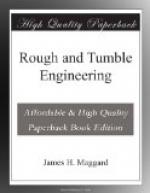The engine has now reached its outward stroke and starts back. The plunger comes back with it and takes the space occupied by the water, which must get out of the way for the plunger. The water came up through the first check valve, but it can’t get back that way as we have stated. There is another check valve just ahead, and as the plunger travels back it drives the water through this second check. When the plunger reaches the end of the backward stroke, it has driven the water all out. It then starts forward again, but the water which has been driven through the second check cannot get back and this space must again be filled from supply, and the plunger continues to force more water through the second check, taking four or five strokes of the plunger to fill the pipes between the second check valve and the hot water check valve. If the gauge shows I00 pounds of steam, the hot water check is held shut by I00 pounds pressure, and when the space between the check valves is filled with water, the next stroke of the plunger will force the water through the hot water check valve, which is held shut by the I00 pounds steam pressure so that the pump must force the water against this hot water check valve with a power greater than I00 pounds pressure. If the pump is in good condition, the plunger does its work and the water is forced through into the boiler.
A clear sharp click of the valves at each stroke of the plunger is certain evidence that the pump is working well.
The small drain cock between the horizontal checks is placed there to assist in starting the pump, to tell when the pump is working and to drain the water off to prevent freezing. When the pump is started to work and this drain cock is opened, and the hot water in the pipes drained off, the globe valve is then opened, and after a few strokes of the plunger, the water will begin to flow out through the drain cock, which is then closed, and you may be reasonably certain that the pump is working all right. If at any time you are in doubt as to whether the pump is forcing the water through the pipes, you can easily ascertain by opening this drain cock. It will always discharge cold water when the pump is working. Another way to tell if the pump is working, is by placing your hand on the first two check valves. If they are cold, the pump is working all right, but if they are warm, the cold water is not being forced through them.
A stop cock should be used next to boiler, as you ascertain whether it is open or shut by merely looking at it, while the globe valve can be closed by some meddlesome party and you would not discover it, and would burst some part of your pump by forcing water against it.
Part third _________
It is very important when the pump fails to work to ascertain what the trouble is. If it should stop suddenly, examine the tank and ascertain if you have any water. If you have sufficient water, it may be that there is air in the pump chamber, and the only way that it can get in is through the stuffing box around the plunger, if the pipes are all tight. Give this stuffing nut a turn, and if the pump starts off all right, you have found the trouble, and it would be well to re-pack the pump the first chance you get.




